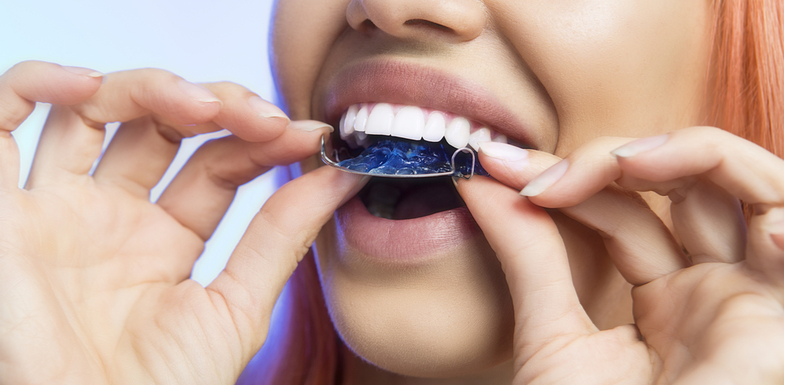You get your braces off and feel free! No more metal, no more finicky flossing and brushing. While it’s true that your gorgeous pearly whites are easier to care for after braces, you now have another orthodontic appliance to manage: retainers. Retainers for teeth help you maintain your beautiful smile, but they require a little bit of care to help them do their job. Here’s what you can expect.
What are retainers for teeth?
Retainers for teeth are like an insurance policy you continually renew every time you pop them in.
Custom-made after bite correction, retainers for teeth help maintain the bite correction you (and your dentist!) worked so hard to achieve.
What are the different types of retainers?
There are three main types of retainers:
- Removable retainers after braces
- Fixed retainers
- Invisalign
Removable retainers after braces
The most common types of retainers are removable retainers after braces. These are usually made of plastic and metal that fits onto your upper teeth and the roof of your mouth.
This type of retainer is created directly after your braces are removed. This is an affordable retainer that can eventually be popped in only at night (although your dentist may prefer you wear it more often).
The main issue with these retainers is patient compliance (wearing them when you are supposed to) and a tendency to lose them (especially for children).
Fixed retainers
Also referred to as permanent retainers, fixed retainers remove some of the pressure for keeping track of and cleaning removable retainers.
This type of retainer is generally fixed to your bottom teeth. A metal bar follows the inside curve of the bottom teeth. It’s cemented into place on either each end or to each tooth. For this type of retainer, the most important part of hygiene is flossing carefully and correctly.
Referring to these retainers as “permanent” is optimistic. They are placed after braces are removed but will not last for the rest of a person’s life. In some cases, fixed retainers will be used for children until they are a little older. After, your dentist will replace them with a removable retainer.
Invisalign
Invisalign retainers pull double duty. Not only do they perform bite correction for slightly misaligned teeth, but they also keep those teeth straight afterwards.
For patients with gaps in the teeth and minor malocclusions (class I and II), Invisalign is a more subtle approach to orthodontics. Many adults who need bite correction will choose Invisalign over traditional metal braces to avoid the stigma of adult braces.
How long do you have to wear a retainer?
The short answer to the question of how long do you have to wear a retainer is simple: for as long as possible. This may seem dramatic, but teeth shift and move in the mouth for your entire life. If you give up wearing your retainers after braces, your teeth will move.
At a minimum, most dentists and orthodontists recommend wearing retainers during the day and at night for at least three months. After that, popping them in at night should keep your teeth in place.
What happens if you don’t wear your retainer?
If you do not wear your retainer, you may experience dental midline shift or other changes that throw off your bite. Your teeth will probably not move back to their original position, but some changes may occur.
When your teeth shift out of alignment, other dental issues can arise, including chipped or broken teeth.
How to clean retainers
There are different methods for cleaning your retainers based on which type of retainer you have. Here’s what we recommend at AZ Dentist.
Cleaning removable retainers for braces
Cleaning removable retainers for braces is similar to cleaning dentures. Rinse them after wearing and soak in water when they are not in your mouth.
Brush your retainers twice daily when you brush your teeth, using the toothpaste or cleaner that your dentist recommends. Cleaning weekly with a denture soak kills bacteria and keeps them fresh. Keep retainers out of the sun and hot water, as the parts may be damaged in high temperatures.
Caring for Invisalign retainers
Your Invisalign retainers are vulnerable to stains and bacteria that can cause bad breath and even tooth decay if not properly cleaned. Each time you remove your retainers (usually to eat and brush your teeth), rinse them in lukewarm water before reinserting them.
In general, Invisalign retainers should be brushed gently twice a day at the same time you brush your teeth. However, avoid using toothpaste on your aligners. Most toothpastes are made with abrasive chemicals that can permanently scratch the surface of your aligners. This creates an ideal atmosphere for stains and bacteria. A paste of baking soda and a drop of vinegar will gently clean your retainers. It will also remove any bad-smells and keep your breath fresh and clean. Rinse thoroughly with warm water before reinserting.
Soaking your Invisalign retainers once a week in a denture cleaner or specialized Invisalign soaking solution will keep your retainers clear and bacteria-free.
Flossing with retainers
While you do not have to specifically clean your fixed retainer, you will need to take special care to floss diligently around it. The bar that sits pressed against your teeth can trap decay-causing bacteria, creating the potential for cavities.
Our dental hygienists at AZ Dentist have a special flossing trick that can make flossing with your fixed retainers a breeze.
Essentially, you create a loop of floss around a tooth and gently pull down to the gum line to get it below the retainer bar. Once you have the floss below the fixed retainer bar, flossing is much easier. If you need to see this trick in action, check this video out.
AZ Dentist is your Phoenix area family dentist, and we know all about retainers. Get in touch today to get all of your retainer questions answered!
